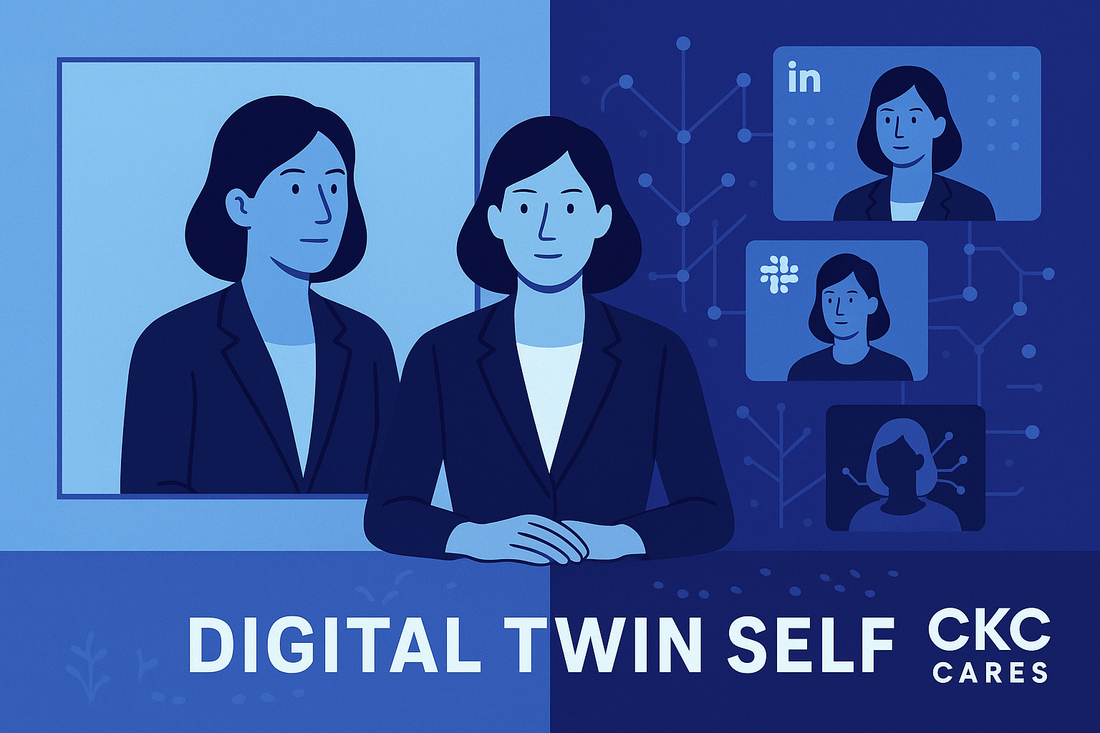
Beyond the Digital Twin: Why Your "AI" Identity Matters
Share
Your LinkedIn profile shows one version of you. Your Slack messages reveal another. Your AI interactions create yet another digital footprint. These fragments form what we call your Digital Twin Self, and it's becoming more influential than you might realise.
The Invisible Identity Crisis
Most professionals experience moments when their digital presence feels disconnected from who they really are. You might be warm and collaborative in person, but your emails come across as terse. Or you're thoughtful and nuanced in conversation, but your AI-generated content sounds generic.
This is cognitive load and authentic leadership, not just personal branding. When there's a gap between your actual self and your digital presence, you spend mental energy managing that disconnect instead of focusing on meaningful work (Ibarra, 1999).
How AI Amplifies Identity Fragmentation
AI systems learn from our digital interactions, but they often capture only surface patterns. An AI might learn that you use certain phrases or prefer particular formats, but it misses the emotional intelligence, cultural context, and intentional pauses that make your communication effective.
The result? AI tools that technically work but don't feel like authentic extensions of your thinking. They might help you write faster, but they don't help you communicate better.
Studies in leadership and digital behaviour show that incongruence between self-perception and digital presentation can lead to decision fatigue, reduced trust in tools, and long-term burnout (Ramarajan & Reid, 2013; Ashforth & Schinoff, 2016).
The Digital Twin Self Approach
While Michael Grieves introduced the Digital Twin in 2002 to model physical systems, Cha’Von Clarke-Joell created the Digital Twin Self in 2025 to help us confront our Digital Saboteurs and manage the Zone of Disrupted Identity, empowering leaders with human-centered tools to remain resilient and values-driven in the age of AI and digital change.
The Digital Twin Self framework helps align your various digital identities with your core values and communication style. We don't need to stress about creating a perfect online persona. We do need to ensure consistency across platforms and tools.
This matters because:
- Trust builds faster when people experience the same authentic you across different channels and tools (Goffee & Jones, 2005).
- Decision-making improves when your AI tools understand what you typically do and why you do it.
- Mental energy is preserved because you're not constantly translating between your authentic self and your digital representations.
Practical Steps to Align Your Digital Twin
Start with Values Mapping
Before optimising your digital presence, clarify what you stand for. What principles guide your decisions? How do you want people to feel after interacting with you? These core values become the foundation for all your digital interactions.
Audit Your Digital Footprint
Look across your professional platforms and AI interactions. Where do you sound like yourself? Where do you feel disconnected? Notice patterns in the gaps.
Design Intentional Bridges
Create simple practices that help you maintain authenticity across digital channels. This might mean taking a breath before responding to important emails or setting up AI prompts that reflect your actual decision-making process.
The Organisational Impact
Teams with aligned Digital Twin Selves communicate more effectively and build trust faster. When everyone's digital presence reflects their authentic professional identity, collaboration becomes smoother and more human.
In healthcare, studies show that clinicians who use voice-based AI or scribe tools often feel displaced when the language or tone generated by these systems doesn't reflect their bedside manner, creating disconnects in patient care (Hollis et al., 2020).
In public sector leadership, digital communication and AI interfaces that fail to represent the nuanced tone of community leaders can lead to decreased public trust. A case study from a UK council’s digital transformation project found that citizen confidence improved significantly when human-centred language protocols were adopted in digital outreach (Local Government Association, 2021).
Organisations can support alignment by:
- Providing training on digital communication and AI interaction
- Creating space for people to experiment with different tools and approaches
- Recognising that effective AI adoption requires human identity work, not just technical training
To deepen this practice, CKC Cares offers the Zone of Disrupted Identity (ZDI) framework, a diagnostic tool and course experience that helps leaders and teams map where their identity is being diluted or disjointed across digital platforms and how to realign it with core values.
Looking Ahead
As AI becomes more sophisticated, the relationship between our human identity and our digital representations will only become more important. The leaders and organisations that invest in alignment now will have stronger foundations for whatever comes next.
Your Digital Twin Self isn't about perfection. Its focus is on authenticity at scale. The more interactions happen through digital channels and AI interfaces, the more maintaining that authenticity becomes a crucial skill for effective leadership and meaningful work.
Want to explore how your organisation can support authentic Digital Twin self-development? Discover our Digital Twin Self™ frameworks designed for leaders managing AI integration.
References
Ashforth, B. E., & Schinoff, B. S. (2016). Identity under construction: How individuals come to define themselves in organizations. Annual Review of Organizational Psychology and Organizational Behavior, 3(1), 111–137. https://doi.org/10.1146/annurev-orgpsych-041015-062322
Goffee, R., & Jones, G. (2005). Managing authenticity: The paradox of great leadership. Harvard Business Review, 83(12), 86–94. Managing Authenticity: The Paradox of Great Leadership
Hollis, V., Konrad, A., Springer, A., Antoun, M., Antoun, C., & Rieger, K. (2020). What does it mean to be a good doctor? A qualitative analysis of AI and the ethics of care. Journal of Medical Internet Research, 22(5), e18301. https://doi.org/10.2196/18301
Ibarra, H. (1999). Provisional selves: Experimenting with image and identity in professional adaptation. Administrative Science Quarterly, 44(4), 764–791. https://doi.org/10.2307/2667055
Local Government Association. (2021). Using digital to build trust and transparency in local government. Local government digitalisation framework: Missions, principles and enablers | Local Government Association
Ramarajan, L., & Reid, E. M. (2013). Shattering the myth of separate worlds: Negotiating nonwork identities at work. Academy of Management Review, 38(4), 621–644. https://doi.org/10.5465/amr.2011.0314

